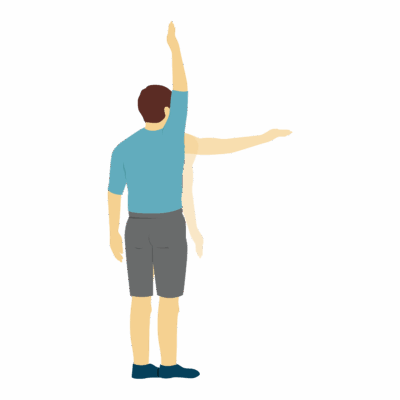Painful Arc Test
The Painful Arc Test is an orthopedic screening maneuver for subacromial impingement syndrome and occasionally acromioclavicular (AC) joint pathology. This test detects the range of motion in which shoulder pain is provoked, helping identify which structures are likely involved.
How the Test is Performed
-
Client stands or sits upright.
-
The client is instructed to slowly abduct the arm (raise it sideways) in the scapular plane from 0° to full elevation (180°).
-
The therapist observes and asks the client to report the onset and offset of pain throughout the movement.
-
Positive Test: Pain is specifically reproduced during the middle portion of abduction (usually between 60° and 120° of elevation) and is less or absent at the beginning (0–60°) and end (>120°) of the arc.
-
Pain above 120° may suggest AC joint involvement; pain throughout may indicate more diffuse or global shoulder pathology (e.g., frozen shoulder, arthritis).
Clinical Significance
-
Pain between 60–120° abduction strongly suggests subacromial impingement, specifically, compression of supraspinatus tendon, subacromial bursa, or biceps tendon under the acromion.
-
Pain outside or beyond this arc may indicate AC joint osteoarthritis (pain at very top/end range), or other shoulder disorders like glenohumeral arthritis or adhesive capsulitis (pain throughout movement).
-
The test is best used with other impingement and AC joint tests for diagnosis, with specificity up to 80% for impingement.
Assessment
-
Use the test in clients reporting painful overhead movement, suspected impingement, AC joint strain, or generalized shoulder pain.
-
Carefully document the specific range and characteristics of pain to guide massage therapy focus and track progress.
Treatment
-
For clients with a positive painful arc (subacromial impingement), avoid deep friction or direct pressure over the supraspinatus tendon/bursa or painful range. The therapist should focus on gentle soft tissue techniques and addressing contributing postural or scapular muscle imbalances.
-
Clients with pain throughout the entire arc may require referral and more cautious, pain-modifying approaches, focusing on supporting structures.
-
If AC joint pathology is suspected (pain above 120°), avoid direct pressure over the AC joint and target periarticular soft tissue for relief.
Safety and Referral
-
If pain is severe, sudden, or functionally limiting, refer the client for medical or physiotherapy evaluation before aggressive manual intervention.
-
Educate clients about avoiding repetitive aggravating movements and encourage postural corrections for long-term resolution.

